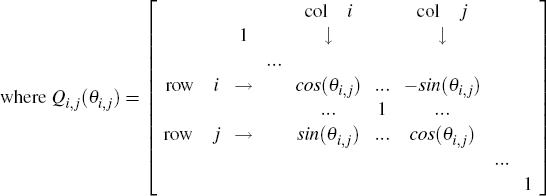RDP 2010-07: Monetary Policy and the Exchange Rate: Evaluation of VAR Models Appendix A: Sign Restriction Algorithm
September 2010
- Download the Paper 335KB
Consider a general VAR(p) model with n variables Yt:
where: A(L) = A1L + ... + ApLp is a pth order matrix polynomial; B is a (n × n) matrix of coefficients that reflect the contemporaneous relationships among Yt; and εt is a set of (n × 1) normally distributed structural disturbances with mean zero and variance covariance matrix Σ, Σi,j = 0∀i ≠ j. The structural representation has the following reduced form:
where π(L) = B−1A(L) and et is a set of (n × 1) normally distributed reduced-form errors with mean zero and variance covariance matrix V, Vi,j ≠ 0∀i,j. The aim is to map the statistical relationships summarised by the reduced-form errors et back into economic relationships described by εt. Let P = B−1. The reduced-form errors are related to the structural disturbances in the following manner:
for some matrix H such that HH′ = p∑p′. An identification problem arises if there are not enough restrictions to uniquely pin down H from the matrix V.
The central idea behind SVAR analysis is to decompose the set of reduced-form shocks,
characterised by V, into a set of orthogonal structural disturbances characterised
by ∑. However, there are an infinite number of ways in which this orthogonality
condition can be achieved. Let H be an orthogonal decomposition of
V = HH′. The multiplicity arises from the fact that
for any orthonormal matrix Q (where QQ′ = I),
such that  is also an admissible decomposition of V, where
is also an admissible decomposition of V, where  . This decomposition
produces a new set of uncorrelated shocks
. This decomposition
produces a new set of uncorrelated shocks  , without imposing zero-type
restrictions on the model.
, without imposing zero-type
restrictions on the model.
Define an (n × n) orthonormal rotation matrix Q such that:
where θi,j ∈ [0, π]. This provides a way of systematically exploring the space of all VMA representations by searching over the range of values θi,j. We generate the Qs randomly from a uniform distribution using the following algorithm:
- Estimate the VAR to obtain the reduced form variance covariance matrix V.
- For both the foreign and domestic block, draw a vector θi,j from a uniform [0, π] distribution.
- Calculate Q, as in Equation (A4).
- Use the candidate rotation matrix Q to compute εt = HQet and its corresponding structural IRFs for domestic and foreign shocks.
- Check whether the IRFs satisfy all the sign restrictions described in Table 2. If so, keep the draw, if not, drop the draw.
- Repeat (2)–(5) until 1,000 draws that satisfy the restrictions are found.




